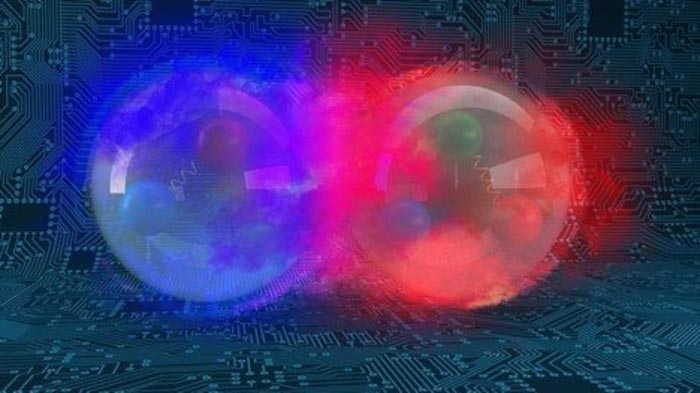

An artist’s representation of two protons colliding. Protons contain quarks and gluons. Computer calculations help scientists understand how quarks and gluons define protons and neutrons.
Image courtesy of Andy Sproles, Oak Ridge National Laboratory
A team studied some of the smallest particles in the Universe on the nation’s fastest computer, Summit at Oak Ridge National Laboratory.
The Science
Scientists use particle accelerators to speed up electrically charged particles to nearly the speed of light. They then smash those particles together to study the new particles that form, including quarks. However, free quarks cannot be directly observed in isolation due to color confinement. This phenomenon means certain particles, including quarks and gluons, cannot be isolated. This makes it difficult to study those particles. Now, a team has developed a new method to simulate how quarks combine and interact to make up the larger particles that form the atom’s nucleus. These simulations need a lot of computing power. One way to make them simpler is to simulate quarks that are heavier than the quarks found in nature. Thanks to the power of the Summit supercomputer, the team simulated much lighter quarks than possible in the past. The combination of the power of Summit with the new method created more realistic results.
The Impact
The team’s results can be compared with experimental studies. These comparisons help nuclear scientists understand how quarks make up neutrons and protons, the larger particles inside atoms in the Standard Model of Particle Physics. Understanding the properties of individual particles may help scientists draw conclusions about what happens near an important particle called the Higgs boson. The Higgs boson is a particle that is associated with a field that appears to give mass to other elementary particles that interact with it.
Summary
Predicting how quarks interact with other particles is a huge challenge in physics. A team has tackled part of this challenge using the Summit supercomputer at Oak Ridge National Laboratory. Summit is the nation’s fastest supercomputer. The team needed to simulate how particles interact while in a vacuum and subject to the strong force. They used simulated snapshots of the strong force field in the vacuum to calculate what would happen as the particles moved through this field. The calculations required the power of the Summit supercomputer because of the large number of vacuum snapshots needed to get meaningful results. In total, the team took more than 1,000 snapshots over three different masses in simulated cubes with grids ranging from 32,768 to 262,144 points in space. This research will allow scientists to apply these results to real-life data, enabling better predictions about subatomic matter.
Funding
This work was supported by the Department of Energy (DOE) Office of Science Nuclear Physics Program and Jefferson Science Associates, LLC. Three of the researchers were supported by DOE Office of Science Graduate Student Research fellowships through the Office of Workforce Development for Teachers and Scientists, Office of Science Graduate Student Research program. Computing time was granted by the John von Neumann Institute for Computing; William & Mary, through contributions from the National Science Foundation and the Commonwealth of Virginia Equipment Trust Fund; the National Energy Research Scientific Computing Center, a DOE Office of Science User Facility; and the Oak Ridge Leadership Computing Facility, also a DOE Office of Science User Facility.
Publications
Joó, Bálint et al., Parton Distribution Functions from Ioffe Time Pseudodistributions from Lattice Calculations: Approaching the Physical Point, Physical Review Letters 125, 232003 (2020). [DOI: 10.1103/PhysRevLett.125.232003]
Media Contact
Michael Church
michael.church@science.doe.gov
Office: 2028416299












